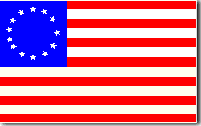Betsy Ross House
239 Arch St.
Philadelphia, PA 19106
(215) 686-1252
www.betsyrosshouse.org
Built in 1740, this nine-room house was occupied by Betsy Ross and her husband John from 1773 to 1786. At the turn of the century two million Americans donated dimes to help restore the house. In 1937 the building was donated to the City of Philadelphia with restoration work undertaken again with the financial assistance of radio pioneer, Atwater Kent. Today the home of the maker of the first American Flag is visited by some 250,000 people annually.
Born Elizabeth Griscom, Betsy was the eighth child of seventeen in a family of Quakers. Following an education in a Friends (Quaker) school, Betsy did an apprenticeship as an upholsterer, which in that day performed a wide variety of tasks involving sewing, including flag-making.
During her apprenticeship she fell in love with John Ross, an Episcopal. They eventually eloped, an act for which Betsy suffered severe consequences. The Quakers, considering interdenominational marriages to be bad, "read" Betsy "out" of the Quaker meeting house, cutting her off  completely from both her religious community and her family. Only three years later she lost John to an explosion as he guarded an ammunition cache for the Pennsylvania Militia.
completely from both her religious community and her family. Only three years later she lost John to an explosion as he guarded an ammunition cache for the Pennsylvania Militia.
Betsy was chosen by the 1776 Congressional Committee on flag design to make the first Stars and Stripes. The Committee consisted of George Washington, Robert Morris, and George Ross, whom Betsy met in her house.
Visitors first enter the Flag Room to see a manikin representing a 24-year old Betsy Ross sewing the Flag. A variety of Betsy's personal effects can be seen here. Upstairs are bedrooms, including the Children's Room and Betsy's bedroom, furnished as they were during the 18th century.
Back downstairs the Upholstery Shop can be seen. The Ross family conducted business from their rented house, a practice popular in those days as it is becoming popular again today.
Other notable sections of the house include the Musket Ball Room, where Betsy sewed pouches to hold gunpowder for the colonists and the Kitchen, completely equipped with the utensils of Colonial times.
The Self-Guided Tour takes in the two of the two-and-a-half stories of the house, plus the basement, and takes about half an hour. Groups are welcome as well as individuals and families. Visitors may purchase an audio guide. While there are no formal programs, School Groups will find great educational value in a tour. The historical importance is obvious.
| Hours: Open daily, 10am - 5pm. Closed Mondays from December through February. | ||
Admission:
|
||
Groups:
|
||
| Group Reservations: Reservations not required for groups wanting a self-guided tour. First come, first served. For the audio tour, groups should reserve at least 2 weeks in advance. Visit the official website (linked above) for full details on group visits. | ||
| Lunch: Snacks served during summer months. Nearby restaurants. | ||
| Handicapped Access: Not accessible. | ||
| Directions: Located at Arch St. between 2nd and 3rd Sts. | ||
Copyright © 1996-2014 by Patrick Tadeushuk. All Rights Reserved.
